
The Generic Universal RolePlaying System, or GURPS, is a tabletop role-playing game system designed to allow for play in any game setting. It was created by Steve Jackson Games and first published in 1986 at a time when most such systems were story- or genre-specific.

A role-playing game is a game in which players assume the roles of characters in a fictional setting. Players take responsibility for acting out these roles within a narrative, either through literal acting or through a process of structured decision-making regarding character development. Actions taken within many games succeed or fail according to a formal system of rules and guidelines.
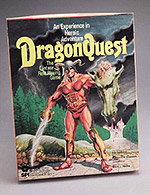
DragonQuest is a fantasy role-playing game originally published by Simulations Publications (SPI) in 1980. Where first generation fantasy role-playing games such as Dungeons & Dragons restricted players to particular character classes, DragonQuest was one of the first games to utilize a system that emphasized skills, allowing more individual customization and a wider range of options.

Mewtwo is a Pokémon, a fictional creature from Nintendo and Game Freak. Created by Ken Sugimori, it debuted in the video games Pokémon Red and Blue, and later appeared in subsequent sequels and spin-off titles, such as Pokken Tournament. In the video games, the player can fight and capture Mewtwo in order to subsequently pit it against other Pokémon. The player first learns of Mewtwo late in Pokémon Red and Blue by reading research documents left in a ruined laboratory on Cinnabar Island. Mewtwo is regarded as one of the series' strongest Pokémon, and was the strongest in the original games in terms of base statistic distribution. It is known as the "Genetic Pokémon" and is a Legendary Pokémon, a special group of Pokémon that are very rare and usually very powerful. Mewtwo has also appeared in various animated adaptations of the franchise.
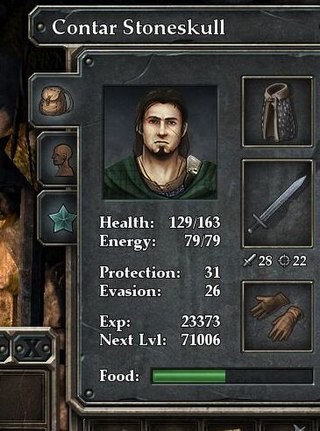
An experience point is a unit of measurement used in some tabletop role-playing games (RPGs) and role-playing video games to quantify a player character's life experience and progression through the game. Experience points are generally awarded for the completion of missions, overcoming obstacles and opponents, and successful role-playing.

Secret of Mana, originally released in Japan as Seiken Densetsu 2, is a 1993 action role-playing game developed and published by Square for the Super Nintendo Entertainment System. It is the sequel to the 1991 game Seiken Densetsu, released in North America as Final Fantasy Adventure and in Europe as Mystic Quest, and it was the first Seiken Densetsu title to be marketed as part of the Mana series rather than the Final Fantasy series. Set in a high fantasy universe, the game follows three heroes as they attempt to prevent an empire from conquering the world with the power of an ancient flying fortress.

A role-playing video game, commonly referred to as a role-playing game (RPG) or computer role-playing game (CRPG), is a video game genre where the player controls the actions of a character immersed in some well-defined world, usually involving some form of character development by way of recording statistics. Many role-playing video games have origins in tabletop role-playing games and use much of the same terminology, settings and game mechanics. Other major similarities with pen-and-paper games include developed story-telling and narrative elements, player character development, complexity, as well as replay value and immersion. The electronic medium removes the necessity for a gamemaster and increases combat resolution speed. RPGs have evolved from simple text-based console-window games into visually rich 3D experiences.
In tabletop games and video games, a character class is a job or profession commonly used to differentiate the abilities of different game characters.
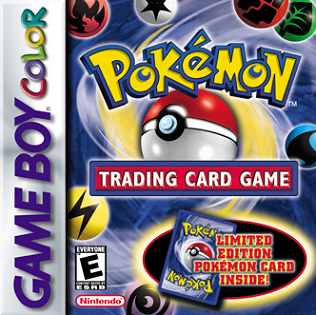
Pokémon Trading Card Game is a video game adaptation of the Pokémon tabletop card game for the Game Boy Color. Developed by Hudson Soft and Creatures, and published by Nintendo, it was initially released in Japan in 1998, and later in the West in 2000. The game features digital versions of cards from the first three sets of the trading card game originally released in English by Wizards of the Coast between 1998 and 1999, as well as exclusive cards not available outside of the game. The game will be released as part of the Nintendo Switch Online service in 2023.
Geneforge is a series of demoware role-playing video games by Jeff Vogel of Spiderweb Software released for Microsoft Windows and Mac OS systems. There are five games in the series: Geneforge , Geneforge 2, Geneforge 3, Geneforge 4: Rebellion, and Geneforge 5: Overthrow. As with all Spiderweb Software titles, graphics and sound are limited because they are not the main focus of the game.
AdventureQuest is an online Flash-based single-player role-playing video game started in 2002 and currently developed by Artix Entertainment. As of March 5, 2019, aq.battleon.com, the game's hosting website, and www.battleon.com, the game's homepage, have an Alexa rating of 54,521.

Paladin's Quest, originally released as Lennus: Kodai Kikai no Kioku in Japan, is a utopian/dystopian science fantasy role-playing video game developed by Copya System and published in Japan by Asmik Corporation on November 13, 1992, for the Super Nintendo Entertainment System. It was published in North America by Enix in October 1993. It was different from other role-playing games at the time, because when the player casts magic, it takes away HP instead of MP.
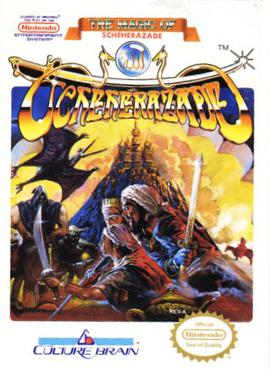
The Magic of Scheherazade is an action-adventure/role-playing video game (RPG) developed and released by Culture Brain for the Nintendo Entertainment System (NES). The game was released in 1987 in Japan and 1990 in North America. The plot is based on Middle Eastern folktales found in One Thousand and One Nights. It involves an amnesic hero traveling through time in an attempt to rescue the princess Scheherazade from the evil wizard Sabaron, who has summoned a horde of demons to bring chaos to the once peaceful land of Arabia. The Magic of Scheherazade is divided into chapters and incorporates elements of both action-adventure and RPG gameplay styles. In each chapter, the player character can freely explore an overworld in a top-down perspective. The player engages hostile enemies with various weapons and spells through both real-time solo action on the overhead map and random, turn-based battles fought alongside befriended allies.

Dungeons & Dragons: Shadow over Mystara is an arcade game developed and published by Capcom in 1996 as a sequel to Dungeons & Dragons: Tower of Doom. The game is set in the Dungeons & Dragons campaign setting of Mystara.

Shadowrun is a cyberpunk-fantasy action role-playing video game for the Super Nintendo Entertainment System, adapted from the tabletop role-playing game Shadowrun by FASA. The video game was developed by Australian company Beam Software and first released in 1993 by Data East.

Lufia & the Fortress of Doom, known as Estpolis Denki in Japan, is a role-playing video game developed by Neverland and published by Taito in 1993, for the Super Nintendo Entertainment System. It is the first title in the Lufia series of video games and the only game from the series released under the Taito label in North America.
Magic systems in games are the rules, limitations, abilities, and characteristics that define magic in a game.

Role-playing games (RPGs) have developed specialized terminology. This includes both terminology used within RPGs to describe in-game concepts and terminology used to describe RPGs. Role-playing games also have specialized slang and jargon associated with them.

An attribute is a piece of data that describes to what extent a fictional character in a role-playing game possesses a specific natural, in-born characteristic common to all characters in the game. That piece of data is usually an abstract number or, in some cases, a set of dice. Some games use different terms to refer to an attribute, such as statistic, (primary) characteristic or ability. A number of role-playing games like Fate do not use attributes at all.
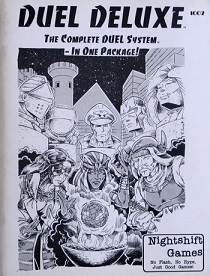
Duel is a combat-focused role-playing game published by Nightshift Games in 1992.













